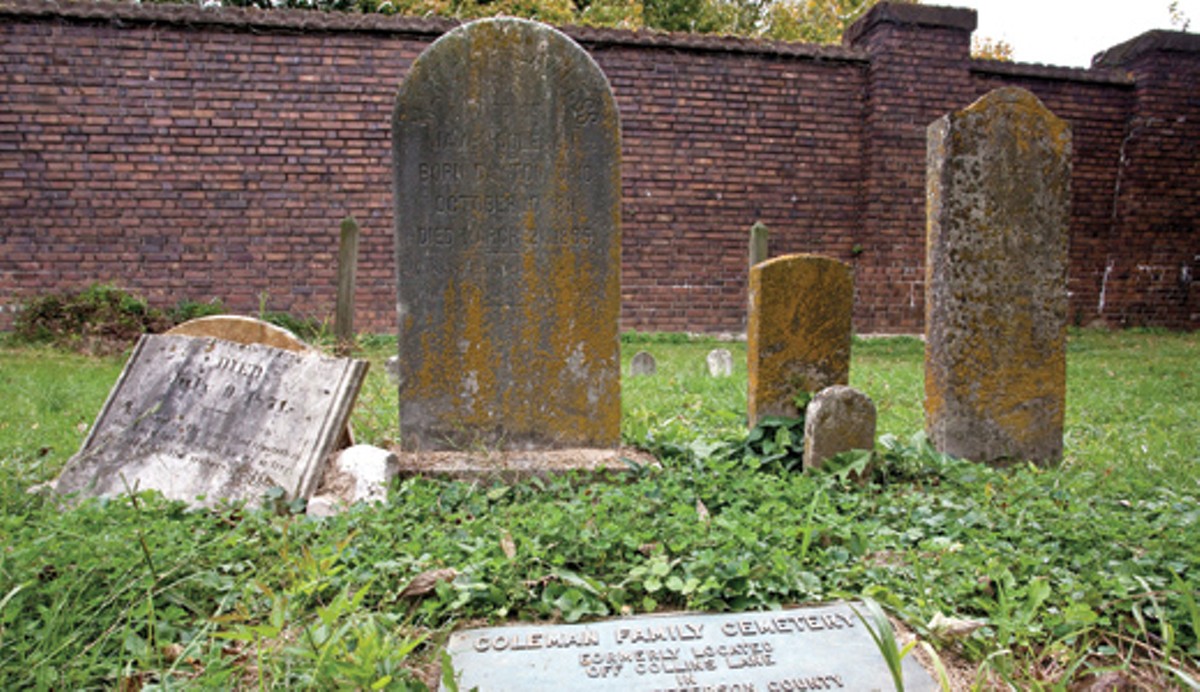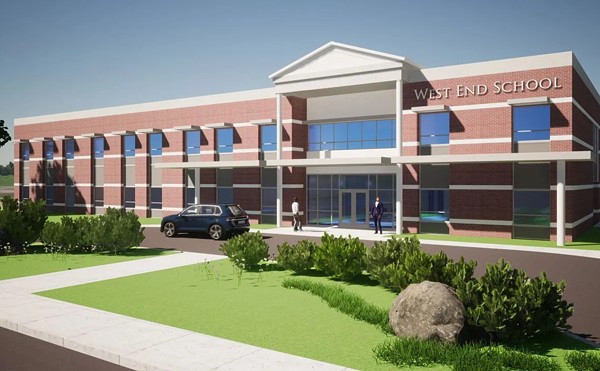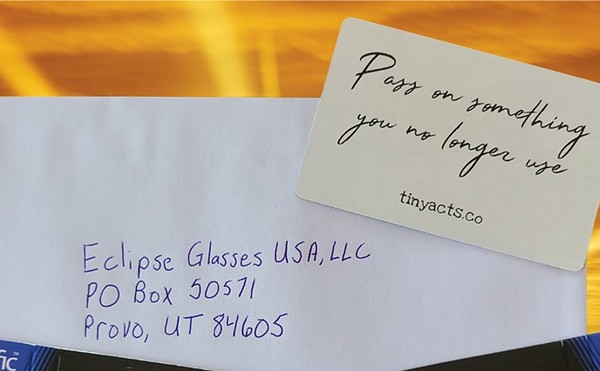One lady staged a one-woman protest by sitting in the center of the road, briefly blocking cars from entering the grounds. Some argue about their rights. Occasionally the cops have to be called, though people always seem to scamper off before the squad car pulls up. Sometimes people claim ignorance and apologize for being there, but it’s tougher to remember those people when the opponents are so vocal. For six months now, they have been testing Andy Harpole’s patience.
Today is no different. Standing on the makeshift curb of the only road winding through Eastern Cemetery on a Sunday morning, Harpole’s mood instantly darkens and his eyes narrow as he notices a middle-aged couple strolling by with two unleashed dogs. The couple doesn’t glance his way, and Harpole only glares from the corner of his eye. There’ll be no confrontation today, maybe because both sides know the other won’t listen, maybe to play nice in front of the reporter.
“I’ve talked to them before,” says Harpole quietly, though the couple is too far away to hear anyway. “They don’t care. They feel entitled.”
Entitled, he explains, to let Fido and Old Yeller use these final resting spots as personal commodes. For years, nearby residents have used Eastern Cemetery as a makeshift dog park. For a place with layers of problems, this is arguably one of the most cosmetic. It’s also one of the most public. It’s spawned Facebook comment battles and an in-person shouting match where somebody may have expressed interest in knowing where a dog owner’s grandma was buried so he could shit on her grave.
“They all say it’s not their dog, that they clean up after themselves,” says Harpole, “but I see their dogs going over hills, getting out of sight. They’re not watching that closely.”
Disrespecting Grandma’s memory by leaving a steamy pile on her marker is bad enough, but a more serious concern abounds. Some dogs like to dig, or they kick up dirt after they’ve done their business, and graveyards — especially this one — aren’t static. Coffins break, bones shift and burrowing animals push things toward the surface. Some Lassie might unintentionally fetch Uncle Petrie’s femur.
“A sense of entitlement shouldn’t come before respect for the dead,” says Harpole. “There are dog parks nearby. Go there.”
Eastern Cemetery, located across the street from Phoenix Hill Tavern, dates back to the mid-1800s. It is believed that burials were conducted as early as 1843, though no records exist for verification. As early as the 1850s, the owners may have started reusing graves. It started with the black graves because they were typically visited less. Then, as cemeteries became desegregated, it spread to other sections. Areas of the cemetery were remapped and renamed. Some bodies were moved without familial permission. Sometimes only the headstones were removed. Plots and graves were sold heavily in the 1920s, and then again in the ’70s.
It took a disgruntled employee in the late ’80s leaving an anonymous tip at the attorney general’s office to start a probe into the now-defunct corporation that owned Eastern and its two small sister cemeteries, Greenwood and Schardein. What was found was a disturbingly institutionalized system of illegal burials in occupied lots.
Graves that were visited or inquired about were filed separately from those that weren’t so staff could keep track of which were safest to resell. The cemetery would plant complimentary bushes for new customers, who would later return and be disoriented because the fast-growing plant had covered up their loved one’s headstone. Minutes from the corporation’s board meetings reflected awareness that space was limited and that something needed to be done.
There had been signs. In the ’60s, during the burial of a teenage boy, a family member wandered around the pile of dirt that was going to be used to fill the grave and found a human skull. The family threw a fit and the boy was relocated to another spot. (Sadly, decades later, when his mother died and the family attempted to bury her next to her son, it was determined that the new plot was also already occupied.)
Mismanagement of cemeteries isn’t unheard of. Many across the country, including the high-profile Arlington National Cemetery in Virginia, have found themselves under investigation for mismanagement or illegal practices. Still, Louisville’s cases are especially egregious.
Estimates vary for how many remains are located at Eastern Cemetery. It’s believed that 130,000 people are buried in 30,000 graves. Evidence of over-burial at Greenwood and Schardein has been found, and existing records suggest there are also unlogged burials.
After news broke of the desecration at Eastern, the board members resigned. Charges were brought up against board members and the corporation but later dropped. The property fell into legal limbo. Phillip DiBlasi, an archaeologist at the University of Louisville, was ordered by the court to handle the property’s records and oversee the future burials of anybody with prepaid plots. Dismas Charities stepped in to mow the grass and do general maintenance, but they’re not able to do more.
So, mostly the property sits. Trash piles up at the fence line. The homeless use the overgrown trees and bushes as shelter when it rains. Teenagers broke into the crematorium, started fires and wrote graffiti like “I’m still alive” until it was finally bricked closed. People headed to Phoenix Hill Tavern use the cemetery as a parking lot. Drunks kick over headstones. Then, of course, there are the dogs.
Every few years, one of these crumbling cemeteries makes the news. Mostly, it’s people complaining about the rundown appearance. Grass up to a reporter’s knees and sound bites of angry families talking about how they cannot find their relatives. The result is a cleanup a short time later, sometimes by Dismas, sometimes by a group of volunteers. Everyone pats themselves on the back, then the cycle continues.
Andy Harpole’s group will be different. Sure, they might all think that, but this time Phillip DiBlasi believes it. For more than two decades, DiBlasi has been the go-to guy for anyone seeking information on Louisville cemeteries. His presence is mandatory at any interment or disinterment at Eastern, Schardein and Greenwood. Additionally, he’s received more than 12,000 requests for the deceased’s records or specific grave locations. Often, he must taper expectations. Record books are hopelessly minimal, and sometimes the person asking for information knows more than DiBlasi does.
Every few years, someone reaches out to ask him what can be done about the deplorable conditions of the cemeteries. He’ll suggest forming a “Friends of ...” group and modeling it after the numerous nonprofits that help preserve or maintain the country’s national parks. Even with this roadmap, DiBlasi says the groups will typically only do a cleanup event or two before fading away as quickly as they came.
Harpole just kept coming back.
In a few months, using mostly a Facebook group he created, he’d amassed 40 or so regular volunteers under the group “Friends of Eastern Cemetery.” Some had already been doing small cleanup projects on site. Others had never heard of Eastern Cemetery but felt compelled to help once they found out about its history.
DiBlasi advised Harpole to think big.
“He told me, ‘This needs to continue after you die,’” says Harpole. “I never realized it could evolve to that level.”
Now, DiBlasi is helping Harpole and a core group of volunteers write bylaws and incorporate as a nonprofit group. Friends of Eastern Cemetery launched a website and started accepting donations. The idea is to create a perpetual care fund that would pay to maintain the property long-term. It would need to generate $50,000 to $60,000 annually just to mow the grass. Additional funds would be needed for one-off maintenance, like clearing fallen trees. Then would come sponsorship for restoring worn headstones, fixing broken ones and replacing those that have been stolen for bronze.
Harpole doesn’t like to talk about all those pie-in-the-sky goals. The way he puts it: “We’re just trying to do what we can.”
Flowers, stuffed animals and tiny little American flags adorn some headstones. Harpole doesn’t have relatives buried at Eastern, and he can only imagine how disheartened visitors must feel when they come to pay respect to someone buried there. Before regular maintenance was established, a few individuals would bring their own lawnmowers and mow from the road to their family’s burial site and back.
Many visitors stop on their way out to thank the volunteer crew for the progress they have made in the past five months. Sometimes Harpole and volunteers introduce themselves in case the visitors might be future volunteers or donors. Whenever he feels like the day’s labor hasn’t gotten them very far and he starts to wonder whether it’s worth all the energy he’s putting into it, those interactions keep him going.
“More and more, we’re starting to see flowers again,” he says. “They’re obviously reaching out to a memory. After all they’ve been through, they keep coming back, so it’s our job to keep doing what we’re doing.”
At the archaeology lab at the University of Louisville, there are rows and rows of urns and plastic tubs of cremated human remains. They were moved here to protect them from the vandals and robbers. DiBlasi started with 600 urns, but now he’s down to about 200. Many of the remains were sought out after relatives read about the collection in The Courier-Journal. One woman’s remains went home with a granddaughter who happened to be touring the lab during an introductory archaeology class.
Some will likely be here forever.
“We have some people from the 1930s,” says DiBlasi. “Who the hell is left for them?”
A few rooms over, a handful of students are typing handwritten cemetery logbooks into a digital database. Some of the books only have the person’s name, date of burial and the assigned plot number. Others also include the cause of death. They’re logging everything. It’s a project years in the making. When it’s done, a person should be able to cross-reference plot numbers with the old maps they recovered from the cemetery and figure out how many people are buried in one area.
The painstaking logging and mapping may also help with any future requests for burials. They happen less frequently now, but occasionally a family will want to reunite a widowed couple or utilize a family plot.
For Don Krauth’s mother, it was both. Mary Nadine Krauth died in 2010. Her wish was to be reunited with her husband, who was already buried near his mother at an Eastern Cemetery plot their family has owned since the very beginning. Don Krauth, the youngest of six and the power of attorney for his mother during her final two years, filed the necessary paperwork with the court and got approval.
Per state law and court orders, if DiBlasi and diggers find a space is occupied, they must stop the burial process and find an alternate location. The Krauths had a backup plan: Move their father to another gravesite in the city that allowed “stacking,” a practice that means exactly what it sounds like and is common in foreign countries.
“This was a great joke and tease for our mother,” wrote Don Krauth via email to LEO. “We constantly asked her to commit to being on top or bottom for eternity!”
The Krauths luckily never had to decide on positioning of their parents. Their Eastern plot still had undisturbed earth, which meant the couple could rest together in the neighborhood their family helped shape. The Krauths have owned family businesses in the Highlands since pre-1900s — most notably H.W. Krauth & Sons Plumbing, Heating & A/C, which was located at Baxter Avenue and Payne Street until 1991, when it moved to its current location on Mellwood Avenue.
Don Krauth says his family plans to continue to bury family members on their lot, not only so they can be together but also in the hopes that others recognize the significance and importance of this oft-forgotten resting place.
Collective memory is important. DiBlasi doesn’t like describing Eastern Cemetery as abandoned. Although nobody outright owns the property, it’s still regularly visited and cared about by many. Thinking about the property as anything but an active feature of the community might do more damage than over-burying.
Just ask anyone familiar with Western Cemetery.
Drive down Jefferson Street in the West End and you’ll come across Western Cemetery. Surrounded by an old short brick wall and a newer wrought-iron fence, there isn’t much to look at. The grass is bright and freshly cut by city workers. It would look like any nondescript field if not for the handful of monuments jutting from the ground. They’re unmistakably grave markers, but it seems odd that there are so few, and so spaced out.
A sign near the entrance warns, “Picnicking Prohibited In Cemetery.”
This, too, is one of Louisville’s long-neglected cemeteries. Unlike Eastern Cemetery, which was privately owned and reluctantly fell into government oversight more than two decades ago, Western Cemetery was always a city-operated graveyard. Buried here are some of Louisville’s oldest residents. They include James Patten, a captain who was one of Louisville’s first residents, as well as veterans from the Revolutionary and Civil wars. Like any old cemetery, plots were grouped into sections — Catholics on the easternmost section (so they could be closest to Jesus during the second coming) and “Africans” on the westernmost section, with designated areas for private plots, public burials and strangers divided between them.
Western opened in the early 1830s, when the city’s original city graveyard filled, and closed in 1894. Then, around 1910, city officials started the process of converting the cemetery into a park — a precedent set by the city’s first public graveyard, which had been converted in 1880 into Baxter Square on Jefferson Street next to the Beecher Terrace projects. In preparation, headstones at Western were removed. One rumor is the stones were ground up and used to pave the roads, though nobody seems to know for sure. Families protested, and a battle raged until the city gave up.
Again, the property sat, mostly ignored, until the city routed 16th Street through the cemetery in the mid-20th century.
Then, in the 1990s, talks of turning Western into a park began again. Phillip DiBlasi was brought in to conduct an archaeological dig to determine whether bodies were still buried on the property — by then, everyone seemed to have forgotten. DiBlasi determined that not only were there bodies still in the green space, but there were also badly desecrated skeletal remains directly underneath 16th Street, as well as evidence of over-burial and grave robbing. Though an actual dig was not conducted, it is widely believed remains would also be found underneath the now-vacant Carnegie Library, located at what was the northwest corner of the original cemetery.
DiBlasi’s findings put an end to plans for a formal park, but many residents still used it informally as a play space until the early 2000s, when a few concerned citizens took umbrage over the fact that people were using the cemetery to host massive picnics during Thunder Over Louisville.
Since then, preservationists have been fighting the city to better Western Cemetery. They pushed to erect the fence that now surrounds the site, as well as new signage reminding everyone the grounds are a cemetery and not a picnic spot. Russell resident John Owen filed an official request to close down 16th Street, but plans have stalled for years due to concerns about traffic impact.
Owen thinks it’s unfortunate the city cares more about commuting issues than the fact that the remains of some of Louisville’s first residents are being driven over daily. He wants the street closed and returned to a natural state.
“This cemetery’s worst enemy has been the city,” says Owen. “This place is a treasure store of information about our city.”
Some of the desecration laws in the Kentucky Revised Statute — ones being touted by the Friends of Eastern Cemetery on the other side of town — were written in response to what happened at Western Cemetery.
Following Harpole and DiBlasi’s lead, Owen and Martina Kunnecke of Neighborhood Planning & Preservation plan to launch a Friends of Western Cemetery group to better organize their mission. Though few monuments remain, they still believe the cemetery could be used as an interpretative space for teaching people about the city.
“Our history is full of conflict. This was real segregation. We could turn this ground into a place that reminds us of what we don’t have to do,” says Kunnecke. It’s an ideal spot for such a mission, she adds, because the African-American Heritage Center property backs right up against the cemetery.
The best-case scenario for Western Cemetery, in DiBlasi’s eyes, would be preserving the memory and keeping the property from ever being used as recreation space. He is not confident in the city’s ability to reverse the damage it did with 16th Street.
“If they would do it right …” he says, “what are the chances of that?”
As for Baxter Square, those grounds have been known primarily as a park for more than 100 years. Reversing that is improbable, though DiBlasi wouldn’t mind doing an archaeological dig there. He suspects the burial methods mirror the French tradition of stacking.
At the very least, Owen wants signage that explains that the park was built atop the city’s first graveyard and memorializes the dead still buried there. Ideally, he’d like the kids’ sprayground and courts removed. Anything less is disrespectful to the dead and, Owen argues, against the law.
Not a week goes by at Preservation Kentucky without an email about cemeteries. President Rachel Kennedy and the group focused on cemeteries hear about many of Kentucky’s cases — graves being disturbed or moved without permission from the families, neglected maintenance, commercial developers coming across previously undiscovered sites. Preservation Kentucky helps connect people with information on their rights and responsibilities. Much of the legalese on cemeteries resides in case law, which means it often goes unknown, gets misinterpreted or remains unenforced.
Kennedy says after 15 years, she is now noticing an uptick in cemetery-related issues — and guardianship interest. She’s not sure why. Maybe things finally hit rock bottom and people began noticing rampant mismanagement. Maybe it’s a delayed reaction to the Great Recession and pinched wallets. Maybe the baby boomers are beginning to die off, giving progeny more incentive to be concerned with the state of graveyards.
Either way, she welcomes the interest.
Over the weekend, Preservation Kentucky held a symposium on cemeteries at the Center for African-American Heritage. Topics included the landscape design of cemeteries, how sites might be used as teaching tools for schools, and KRS legislation as it currently stands and what changes might benefit it.
Cemeteries are natural places for interpreting people’s life stories, says Kennedy, especially those who maybe aren’t big enough to have a building or street named after them but are still a vibrant sparkle in the city’s colorful history. Cave Hill, she says, is interpreted beautifully and has become a tourism spot. Developing heritage and educational tourism for other cemeteries makes sense.
After the symposium, smaller group workshops were held at Eastern Cemetery to focus specifically on restoring old tombstones. Both “Friends of” groups are a long way from being ready to restore headstones, but hearing about the latest techniques motivated them to continue their overall efforts.
Joel Berndt already knows which tomb he wants to restore first. The Friends of Eastern Cemetery volunteer has unknowingly been parking next to it regularly over the last five months while attending cleanup sessions. To most, it’s likely unremarkable — a short, dark grey slab jutting from the ground at a 45-degree angle. Chiseled into it are three initials: His, J.A.B.
This coincidence piques Berndt’s interest. I ask if he has any relatives buried at Eastern. “I’m adopted,” he replies. “Everyone buried here could be.”
Only in the United States is there the concept that you will be buried in the ground and remain there forever. Most other countries have a system of disposing the dead that doesn’t involve a tombstone for life. The French, dealing with an overcrowding of bodies in the 1700s, invented an ossuary system in which two members of a family were placed into an aboveground tomb, then their bones eventually deposited into a pit below that tomb once the next member of the family died.
Americans likely know it best as the system used in New Orleans. A popular myth suggests the city’s aboveground tombs exist because of an unstable water table that causes any belowground graves to be pushed out of the ground, zombie-style. The reality is that the city just adopted a more sustainable burial system. It acknowledges that space for the dead is finite without removing all chances of a physical structure that memorializes them.
It’s more romantic to think about having a six-foot plot for eternity, but that business model isn’t sustainable, especially as populations boom. In many countries, families rent, not buy, a plot of land for their deceased and stack coffins. Stop paying for the plot, and the landowners will dig the bodies up and cremate them. It might seem crude, but it works.
The commercialization of death — the move from small, church-owned graves or family plots on farms to maintained properties for the community at large — is relatively new.
Spend enough time cruising Louisville’s neglected cemeteries and maybe you’ll start thinking differently about being buried. Harpole and the Friends of Eastern Cemetery volunteers have uncovered dozens of headstones that haven’t seen the light of day in years. Kennedy of Preservation Kentucky learned after a visit to one of the state’s rural cemeteries that she’d been the only visitor in a year. That surely isn’t something the people buried there would have imagined.
Harpole doesn’t want to be buried; that was true even before he started working extensively at Eastern. He’d like a Tibetan sky burial, in which a body is placed high atop a mountain, where vultures would eat the body. In cultures that practice sky burials, it’s viewed as symbolic. Harpole also likes the idea of having his body eaten by a gaggle of flesh-eating beetles and his skeleton articulated. (In addition to his day job of running a boat-repair shop and setting up Friends of Eastern Cemetery, Harpole owns the Louisville Stigmatorium, which focuses on oddities and strange collectibles, including articulated skeletons.)
He wouldn’t mind being cremated and his ashes spread — maybe even at Eastern.
Whatever the choice, however atypical, he wants it to be natural, and he wants it respected.
“Final wishes should be honored,” he says. “I don’t see the need to be buried and visited by people forever, but I respect people’s desires.”
For more information on Friends of the Eastern Cemetery, visit friendsofeasterncemetery.com or the group's Go Fund Me page






